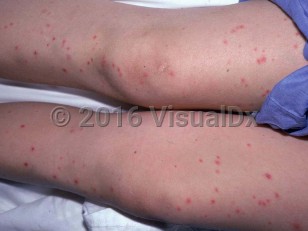Trichosporon sepsis in Adult
Alerts and Notices
Important News & Links
Synopsis

Trichosporon species are ubiquitous yeasts found in soil and water as well as being common human mucosal colonizers (gastrointestinal, vaginal, and respiratory).
The genus Trichosporon was reclassified in 1992. The commonly used term Trichosporon beigelii was rejected at that time. Six species are associated with human disease: Trichosporon ovoides and Trichosporon inkin are associated with superficial hair shaft infection (white piedra), while both of these and Trichosporon cutaneum and Trichosporon asteroides have caused superficial skin disease, onychomycosis, and otomycosis. Systemic infection in immunocompromised patients is usually attributed to Trichosporon asahii and sometimes Trichosporon mucoides. More recently, Trichosporon loubieri and Trichosporon pullulans have also been identified as a cause for systemic disease.
Most systemic disease is believed to originate from endogenous colonization. Localized disease has occurred in heart valves, the central nervous system (CNS), urinary tract, eyes, peritoneum, surgical wounds, and skin. Disseminated disease is more commonly reported than localized disease. This often presents with a fungemia and sometimes subsequent gastrointestinal, lung, or kidney involvement. Symptoms and signs may reflect the organ involved (eg, flank pain with hematuria, pulmonary infiltrates).
Neutropenia is the most important predisposing risk factor. Other risk factors include hematologic malignancy, preceding corticosteroid or antibiotic use, intravenous (IV) catheters, extensive burns, prosthetic heart valves, low birth weight premature infancy, hemochromatosis, and HIV infection.
Invasive disease is more common in males and is primarily reported in adults, although it has been recognized as a pathogen in neonates.
Disseminated disease is often lethal in immunocompromised hosts (greater than 60% mortality rate).
The genus Trichosporon was reclassified in 1992. The commonly used term Trichosporon beigelii was rejected at that time. Six species are associated with human disease: Trichosporon ovoides and Trichosporon inkin are associated with superficial hair shaft infection (white piedra), while both of these and Trichosporon cutaneum and Trichosporon asteroides have caused superficial skin disease, onychomycosis, and otomycosis. Systemic infection in immunocompromised patients is usually attributed to Trichosporon asahii and sometimes Trichosporon mucoides. More recently, Trichosporon loubieri and Trichosporon pullulans have also been identified as a cause for systemic disease.
Most systemic disease is believed to originate from endogenous colonization. Localized disease has occurred in heart valves, the central nervous system (CNS), urinary tract, eyes, peritoneum, surgical wounds, and skin. Disseminated disease is more commonly reported than localized disease. This often presents with a fungemia and sometimes subsequent gastrointestinal, lung, or kidney involvement. Symptoms and signs may reflect the organ involved (eg, flank pain with hematuria, pulmonary infiltrates).
Neutropenia is the most important predisposing risk factor. Other risk factors include hematologic malignancy, preceding corticosteroid or antibiotic use, intravenous (IV) catheters, extensive burns, prosthetic heart valves, low birth weight premature infancy, hemochromatosis, and HIV infection.
Invasive disease is more common in males and is primarily reported in adults, although it has been recognized as a pathogen in neonates.
Disseminated disease is often lethal in immunocompromised hosts (greater than 60% mortality rate).
Codes
ICD10CM:
A41.89 – Other specified sepsis
SNOMEDCT:
700054008 – Sepsis caused by fungus
A41.89 – Other specified sepsis
SNOMEDCT:
700054008 – Sepsis caused by fungus
Look For
Subscription Required
Diagnostic Pearls
Subscription Required
Differential Diagnosis & Pitfalls

To perform a comparison, select diagnoses from the classic differential
Subscription Required
Best Tests
Subscription Required
Management Pearls
Subscription Required
Therapy
Subscription Required
References
Subscription Required
Last Updated:02/23/2022

